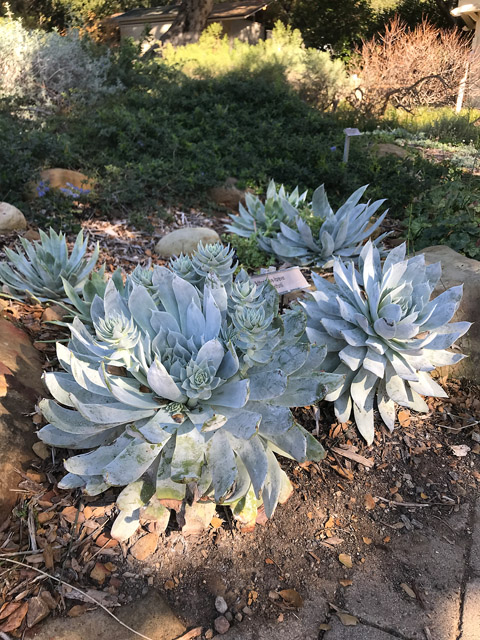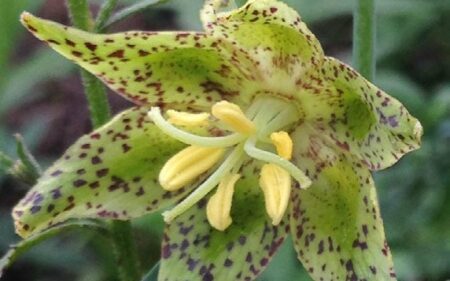Dudleya | Celebrating California’s Star Succulent

What is a Dudleya?
Dudleya, sometimes commonly called liveforevers, is a genus of about 65 species and subspecies. Members of the stonecrop family (Crassulaceae), these succulent plants are closely related to garden center staples like hens and chicks (Echevaria species). Dudleya often grow in marginal habitats that are difficult for other plants to colonize, such as the edges of steep cliffs or cracks in boulders. Many Dudleya species are found in these harsh environments and are well-adapted to California’s long summer dry season, earning them one of their common names, liveforever.

Dudleya is an important food source for butterflies, hummingbirds, and other animals. For example, the Sonoran blue butterfly (Philotes sonorensis) lays its eggs exclusively on leaves of the low canyon Dudleya (Dudleya cymosa subsp. pumila), which serves as a delectable meal for the newly hatched caterpillars. These succulent plants have incredible diversity in size and form, from the diminutive Dudleya nesiotica found on Santa Cruz Island, to the hulking Dudleya brittonii that can grow half a meter wide.


The Unique and Threatened Dudleya
Some Dudleya species are chalky white, as a special form of plant sunscreen (Dudleya pulverulenta), sporting the highest UV reflectivity ever discovered in the plant kingdom. Other species of Dudleya sprout sticky and fragrant green leaves (Dudleya viscida and Dudleya anomala). Some species are even deciduous, giving up their leaves in the summer heat and surviving as an underground corm, or storage organ (e.g. Dudleya brevifolia).
Many of the different types of Dudleya are restricted to certain soil types or habitat, meaning the whole population might occupy a small geographic area. This makes them more vulnerable to threats than widespread species, such as fire or habitat destruction. As you might guess from their small ranges, nearly half of the taxa in the state of California are considered rare or threatened. Compounding this, these plants are now increasingly the target of large international poaching schemes catering to the demands of hobbyist collectors.

The Garden’s Dudleya Collection
Our Living Collection is centered on the plants of California and a region known as the California Floristic Province. This region is defined by having an unusual Mediterranean Climate with hot dry summers and cool wet winters. The California Floristic Province (CA-FP) stretches from Oregon to Baja California, and inland to the edge of the Mojave Desert. The CA-FP is home to one of the most diverse ecosystems on the planet, and Dudleya are an important facet of that diversity. Dudleya have what scientists call their center of diversity within the California Floristic Province. Simply put, the center of diversity is the place where the greatest number of species and subspecies can be found. Keeping all of that in mind, it’s no surprise the Garden has held collections of Dudleya for decades! The Dudleya specimens in our Garden are all accessioned, which means that we have records of where they came from, when they were collected, and other vital biodata. This accession data is ultimately what makes the plants in our collection so important, since it means these specimens are useful for research, conservation, and restoration efforts.
Our earliest specimens of Dudleya come from the 1950s and many are collections from the Channel Islands of California. Our earliest recorded accession of Dudleya is still thriving in the Garden today. The Dudleya caespitosa (sand lettuce) was collected from the mouth of the Ventura River in 1958.
Our Garden’s scientists have contributed to the breadth of the Dudleya collection and our scientific understanding of this group over the decades. Studies on these amazing plants continue here today including our work to assess the status of rare Dudleya following the Woolsey fire and our genomic analysis to access the interactions between the rare Verity’s liveforever (Dudleya verityi) and a more widespread species, lanceleaf liveforever (D. lanceolata).
Our Dudleya collection is accredited as part of the Plant Collections Network (PCN) by the American Public Gardens Association (APGA). These accredited plant collections are a way to safeguard plant diversity and important collections of plants held by botanic gardens in the long term as shifts in staffing, budgetary priorities, and other changes occur. PCN collections are often taxonomic, or focused on a single closely related group of plants, like our Dudleya Collection. They can also be focused on ecology, like Denver Botanic Garden’s collection of Alpine Plants. Being a part of the PCN with an accredited collection also gives us access to various resources, including other professionals who can assist with the curation and growth of our collection. The Garden applied for accreditation of our Dudleya collection in 2000 and was one of the earliest APGA-accredited collections.
What is a Taxonomic Collection?
Taxonomic collections are natural history collections that focus on a single group of closely related plants, or taxon. Taxon is how biologists refer to groups of closely related organisms without specifying a rank. Think back to your biology class, at some point you probably learned about the ranks in the taxonomic hierarchy: Kingdom, Phylum, Class, Order, Family, Genus, and Species. Taxon may mean a group of related plants at any one of these ranks, plus, the plural taxa can refer to multiple of them. So, taxa can mean all the plants within a genus, including all the species and subspecies.
A taxonomic collection might focus on one genus of plants, like our Manzanita collection (Arctostaphylos). Or the Desert Botanical Garden’s more broadly focused collection of the cactus family (Cactaceae). Whatever their focus, these collections are multipurpose displays that showcase plant diversity for visitors and support scientific research and sampling.
The Garden and other botanic gardens serve as vital tools for biodiversity conservation and when their collections are focused, they become an even more powerful resource. Once a botanic garden has an established taxonomic collection, it becomes a repository for specimens of that taxon, and a “one stop shop” for researchers looking to study certain aspects of that taxon’s biology.
The History of our Dudleya Display

Some long-time visitors may remember we once featured a Dudleya display in the northwest side of the Garden, as part of the Meadow Section. This original display was installed in 1993 and featured 44 different taxa of Dudleya, many from the Channel Islands of California. The plants thrived there for years, but eventually started to decline after the 2009 Jesusita Fire injured some of the large trees in that section. This left most of the area open and it became one of the hottest areas within the garden, which you can feel for yourself when you visit today. This heat ultimately led to the decline of many of the plants in the display. The accession labels were also damaged, and many of the remaining plants were left with tags featuring only a partial accession number, or no accession number at all! This means that many of the plants were separated from their accession record, their names, their origins, and everything else that makes them critical as specimens in a Living Collection.
When I arrived in 2021, only a few plants remained in the display, and these were suffering. Our Grounds Manager Stephanie Ranes and I made the decision to find this special display a new home within the Garden. Part of this effort started with one of my first assignments at the Garden – to audit our Dudleya collection so we could rebuild the display. Fortunately, the entire Dudleya collection was not isolated to that one area. There were many important specimens growing throughout the Garden we could take cuttings from to replenish the display. Many plants had already been moved to the Nursery for rehabilitation, so we had some plants waiting in the wings. With some help from experts on the genus, I was eventually able to identify many of the specimens with damaged accession tags. This process involved painstakingly identifying plants, and then matching them with accession information we could confirm and using old photos and our records of the plants in the display. Sadly, some specimens still lack their full accession details, but they still contribute to the taxonomic diversity in our collection.
Introducing our New Dudleya Display

After two years of hard work from our team, we are finally ready to reintroduce our Dudleya display to visitors. Years of growing and tending the plants, identifying them, combing through records, site research, and arduous site preparation have paid off. We now have a new display we are extremely proud to show off.
Our Horticulture Team learned new skills to create this display, including detailed rock work to build terraces. Each of these terraces was then filled with gravel and a well-draining mixture of soil to help the Dudleya plants thrive in their new home. This new display will be cared for by Phoebe Swigart, one of the Garden’s many talented gardeners.
We are still working on the finishing touches for the display, which will include gravel on top of the soil, as well as signage to help visitors learn about this unique collection. So far, the plants are very happy in their new homes!

The new Dudleya display is in the Arroyo Section of the Garden on an east-facing slope near the Home Demonstration Garden Section. This rocky area is similar to the natural habitat for many of the Dudleya species featured in the display, and we hope it will be an excellent home for them for years to come.

The new display is organized geographically, and currently features 22 taxa from mainland California, the California Channel Islands, and Baja California as well as two unique Dudleya cultivars: D. ‘Frank Reinhelt’ and D. ‘White Sprite’. The location of each plant in the display has been mapped and photographed, and the plants have been tagged to help ensure no accession information is lost.
What you see in this display today represents just over half the taxa in our Dudleya collection. We are still working to propagate more of these plants so that they can be added to the display. Currently, those plants are not on display because we only have a handful of individuals so they are precious! We also plan to continue adding diversity by collecting and cultivating new types of Dudleya.
Next time you visit the Garden, please stop by and check out these incredible plants for yourself. Keep your eyes peeled, as we are still planning to add finishing touches to complete the display this spring.
Conservation Takes a Community, Thank you!
I am so thankful for the many people whose hard work made this display possible. I want to especially thank Gardeners Jacob and Bryan for their work preparing the site, Gardener Phoebe who dug out a ton of rocks and planted each one of the precious Dudleya, Grounds Manager Stephanie who planned and coordinated this project and ensured everything ran smoothly, and finally, our Living Collections Coordinator Katie who helped to curate the display and keep all the records straight.
I am also thankful for identification help from the Garden’s Research Associate Tom Mulroy, Ph.D. and taxonomic expert on Dudleya, Steve McCabe.
 Donate
Donate




